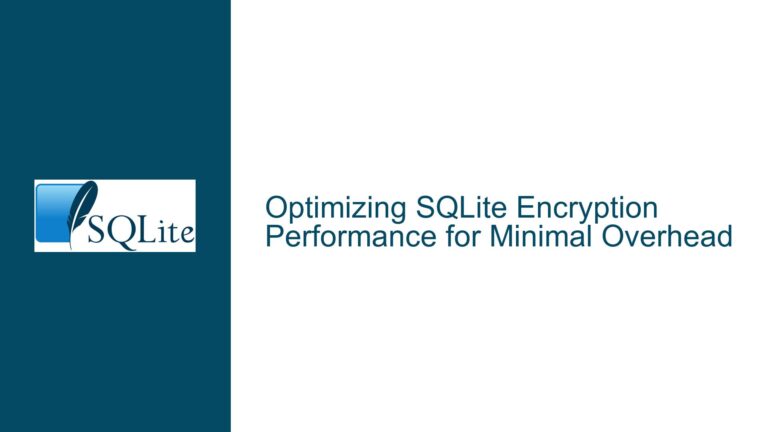WAL Mode Behavior and Optimizing Checkpoints in SQLite
Issue Overview: WAL File Growth and Checkpoint Behavior in SQLite
In SQLite, the Write-Ahead Logging (WAL) mode is a popular mechanism for improving concurrency and performance by allowing readers and writers to operate simultaneously without blocking each other. However, the WAL file can grow significantly under heavy workloads, especially when checkpoints are not performed efficiently. This growth can lead to performance degradation, increased memory usage, and potential issues with data integrity if not managed properly.
The core issue revolves around the behavior of the WAL file when it grows to a large size, such as 65,536 frames, and how checkpoints interact with this growth. Specifically, the concern is whether frames that have already been checkpointed (e.g., frames 1 to 40,000) will be read again by subsequent transactions. This is particularly important in systems with a high volume of readers and a single writer, where the goal is to minimize the impact of checkpoints on ongoing transactions.
The WAL file consists of a series of frames, each containing a page of data that has been modified by a transaction. When a checkpoint is performed, the modified pages in the WAL file are written back to the main database file, and the WAL file is truncated to remove the frames that have been checkpointed. However, if the checkpoint process does not complete fully or if there are still active readers that are using the WAL file, the WAL file may not be truncated, leading to continued growth.
In the scenario described, the checkpoint has moved the nBackfill pointer to frame 40,000, indicating that frames 1 to 40,000 have been checkpointed. The question is whether these frames will be read again by new transactions, even though the data they contain has already been written to the main database file. This is crucial for determining whether a ring buffer can be used to manage the WAL frames in memory, allowing for efficient reuse of memory and avoiding the need to allocate additional memory for the WAL file.
Possible Causes: Why WAL Frames May Be Read Again After Checkpointing
There are several reasons why WAL frames that have been checkpointed might still be read by subsequent transactions, even though the data they contain has been written to the main database file. Understanding these causes is essential for optimizing the checkpoint process and ensuring that the WAL file does not grow indefinitely.
Active Readers and Transaction Isolation: In SQLite, readers that started before a checkpoint was performed may still need to access the WAL file to read data that was modified after they began their transactions. This is because SQLite provides transaction isolation, meaning that each transaction sees a consistent snapshot of the database as it existed at the start of the transaction. If a reader started before the checkpoint, it may still need to read from the WAL file to access data that was modified after the checkpoint began but before the reader started.
Incomplete Checkpoints: If a checkpoint does not complete fully, either because it was interrupted or because there are still active readers using the WAL file, the WAL file may not be truncated. In this case, the frames that were checkpointed may still be present in the WAL file, and new readers may need to read from these frames if they are part of the transaction’s snapshot.
Memory VFS and Process Termination: In the scenario described, the main database and WAL file are stored in memory using a virtual file system (VFS). When the process exits, everything is destroyed, including the WAL file. If all clients exit without fully checkpointing and deleting the WAL file, the fact that the first 40,000 frames of the WAL file have already been checkpointed is forgotten. New readers will again read data from any frame of the WAL file, including frames that were previously checkpointed.
WAL Index Hash Performance: The performance of the WAL index hash, which is used to locate frames in the WAL file, may also play a role in whether checkpointed frames are read again. If the WAL index hash is not optimized, it may take longer to locate frames in the WAL file, leading to increased read times and potential performance issues. The speed of the WAL index hash may depend on the total size of the WAL file or just the size of the frames that have not been checkpointed (i.e.,
MaxFrame - nBackfill).
Troubleshooting Steps, Solutions & Fixes: Optimizing WAL Mode and Checkpoint Behavior
To address the issues related to WAL file growth and checkpoint behavior, several steps can be taken to optimize the performance of SQLite in WAL mode. These steps include ensuring that checkpoints are performed efficiently, managing the WAL file size, and optimizing the WAL index hash for faster frame lookup.
Ensure Complete Checkpoints: One of the most important steps in optimizing WAL mode is to ensure that checkpoints are performed completely and that the WAL file is truncated after a checkpoint. This can be achieved by ensuring that all active readers have finished their transactions before the checkpoint is performed. If there are still active readers using the WAL file, the checkpoint may not be able to truncate the WAL file, leading to continued growth.
Monitor and Manage WAL File Size: It is important to monitor the size of the WAL file and take steps to manage its growth. This can be done by setting a maximum size for the WAL file and performing checkpoints when the WAL file reaches this size. Additionally, the
PRAGMA wal_autocheckpointcommand can be used to automatically perform checkpoints when the WAL file reaches a certain size.Use a Ring Buffer for WAL Frames: In systems with a high volume of readers and a single writer, using a ring buffer for WAL frames can help manage memory usage and avoid the need to allocate additional memory for the WAL file. By reusing frames that have been checkpointed (e.g., frames 0 to
nBackfill), the ring buffer can help reduce the overall size of the WAL file and improve performance. However, it is important to ensure that frames that have been checkpointed are not read again by new transactions, as this could lead to data inconsistencies.Optimize WAL Index Hash Performance: The performance of the WAL index hash can have a significant impact on the overall performance of SQLite in WAL mode. To optimize the WAL index hash, it is important to ensure that it is designed to handle the size of the WAL file efficiently. This may involve using a hash function that is optimized for the specific size of the WAL file or using a different data structure for frame lookup, such as a B-tree or a skip list.
Handle Process Termination Gracefully: In systems where the main database and WAL file are stored in memory, it is important to handle process termination gracefully to ensure that the WAL file is checkpointed and truncated before the process exits. This can be done by implementing a shutdown procedure that performs a final checkpoint and deletes the WAL file before the process exits. This will ensure that new readers do not need to read from frames that were previously checkpointed.
Use WAL Mode with Care in High-Concurrency Systems: While WAL mode can improve concurrency and performance in many cases, it is important to use it with care in high-concurrency systems with a large number of readers and writers. In such systems, the WAL file can grow quickly, leading to performance issues if not managed properly. It may be necessary to implement additional mechanisms, such as limiting the number of concurrent readers or writers, to ensure that the WAL file does not grow too large.
Consider Alternative Storage Engines: In some cases, it may be necessary to consider alternative storage engines or database systems that are better suited to high-concurrency workloads. For example, some databases use a multi-version concurrency control (MVCC) mechanism that allows readers and writers to operate simultaneously without blocking each other, while also managing the size of the transaction log more efficiently.
By following these steps, it is possible to optimize the performance of SQLite in WAL mode and ensure that the WAL file does not grow indefinitely. This will help improve the overall performance and reliability of the database, especially in high-concurrency systems with a large number of readers and writers.






